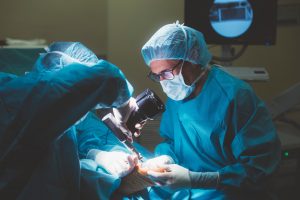Progress Through Communication
Part 7: The History of Podiatry in the Making
Progress through communication is pivotal to patient centred practice. First of all the profession needs to know where it has come from in order to improve. In this article I step back a little to see where we have come from and highlight some of the earlier attitudes. All professions need to establish their identity through clear objectives of how to achieve their role, and evidence to support their effectiveness in the healthcare market. With collaborative Multi-Disciplinary Teams now in play, reworking our role has never been more important. Having interviewed a few podiatrists the multi-disciplinary angle does not just exist within the NHS. With more independent podiatrists than full time NHS podiatrists, clarity of function is vital. Success is undoubtedly related to having a strong foundation of knowledge, expertise, evidence of effectiveness and confidence within one’s chosen profession. Social media dictates the speed of communication with brevity, and can influence market forces. Cautionary tales were covered in the January 2021 edition of The Podiatrist (McConnachie) Telemedicine has started to emerge, and yet has not been studied in sufficient detail to comment on the long term benefits. Corona virus 2019 has certainly expanded the potential for telemedicine and yet podiatry has yet to show its head

Past attitudes
The former Podiatry Association (1974-1996) initially had a newsletter that escalated to the Journal of Podiatric Medicine & Surgery by 1991. ‘Our journal/ Newsletter is meant to reflect the standard that podiatry has reached in this country…please do not leave it to the same few people to write the articles…’[1] The urgency to publish was never truer at a time when few UK texts existed and reliance fell to US publications.

Early forms of marking a brand
For any profession providing a service, the brand is important. Brands should be visual and convey instant meaning within a competitive market. Medicine adopted the ‘serpent’, often two snakes entwined around the rod or staff carried by Hermes, the patron saint of travellers. This evolved from Greek mythology in reference to healing the sick. Podiatrists heal within the framework of diseases and medicine but in a different manner to traditional medicine. The wings, known as caduceus helped speed travel. Doctors often travelled far and wide to treat patients. Most versions of the rod relate to the demi-god Asclepius regarded as the Greek God of medicine. Many drug companies today use the same image of the rod, serpent and wings to establish ‘medical’ credentials.
Straplines make short statements.
Podiatry has used Latin strap lines in common with medicine. Latin subscript is outdated but offers a little philosophical gravitas; Omni Pede Stare[2] (make every exertion, or use every effort) used by the former Podiatry Association contrasted with the Society motto- Post Curam Otium (ease aftercare). The language is academic and of little value in everyday life. Our profession is ‘health’ yet how many could succinctly define what we do as podiatrists? The model we have adopted is medically based. We are medically trained but not medically qualified. Subjects within podiatry comprise medical sciences and cannot be divorced from our role as specialists in surgery. Like it or not, we have the same duty as any medical doctor. How often today do medical referrals consider the suitability for surgical selection?

Disputes over fees
Trawling through Facebook messages of one site I was interested to read recently, many podiatrists had patients object to the fee being charged. Of course, replies came back in flurries, infuriated that anyone should challenge the fee being charged. Communication applies to fees as much as it does to services. Many gurus are now making a living trying to guide independent practitioners in how to deliver business. In some ways, this absence of ability has often had to be learned on the hoof. Many just want to help patients and feel uncomfortable talking money. Perhaps the NHS provides a cushion for this inevitable quandary. Charging a fee is far from arbitrary. Covid-19 has just taken the costs of delivering practice to all new heights with observing distance, reducing air borne particles carrying the virus, using PPE and of course reducing clients during sessions where before twice if not more patients could be seen. Survival in practice can only come from ensuring you can cover costs. My adage was that it was better to see fewer patients at the right price than see more at the wrong price. Practitioners within the health field cannot act as a conveyor belt when quality and standards are paramount.

What defines us?
Can we explain the difference between a chiropodist and podiatrist, or a podiatrist and podiatric surgeon? Do you know why a podiatric surgeon is important? What defines us? Professional identity may be tied into a set of values that defines one working role from another. When it comes to how a podiatric surgeon differs from a podiatrist, this should hold little difficulty. The original objectives behind foot surgery involved managing pain, preserving tissue, improving structure and deformity, and restoring mobility. All podiatrists can contribute to these objectives but only the podiatric surgeon can interconnect between all of four aims.
Attitudes from others
In Podiatry Now[3] in 2018 there was a question as to whether the profession really had met its obligation over its’ responsibilities? Former Chair of Council Debbie Delves reported that members of the organisation still feel public understanding emanates from an absence of communication and is a key concern that needs resolving [4]. The only problem today is how to project such a variety of options that benefits both the public and the profession? The world has changed; the speed of transmission raises expectations for instant delivery and recognition. Few texts exist that depict UK podiatry, many that do are outside the pocket of students let alone practising podiatrists. The latest text is Podiatric Medicine [5]. The contents reflect an extension to the role of podiatry, and immersed within medical literature.
Negative stereotypes
Negative stereotypes have dogged the profession since the emergence of chiropody. One of the most significant effects of independence through the British Medical Auxiliaries Register 1938 was reducing the importance of cohesive identities brought about by teamwork. The vestigial effect of pedicure allied to nails and skin remains. One of the more destructive forces within podiatry has been some belief that one group is superior [6].

Do negative stereotypes come from us or from others?
Broom cupboard podiatry rooms of the past no longer meet safety standards (Graham, 2017). Modern podiatry clinics look more like dental surgeries today, but even with these upgrades, the image remained flawed by a disparate approach to podiatry. Nippers are widely available to the public as an instrument, and nails are considered pedicure. Management can be performed by anyone able to bend. The importance of image is vital for rapid communication by association. Association with TV adverts offer powerful messages. A toothpaste advert on the TV conveys the prominence of dentistry as a healthcare deliverer. This subliminal drip-drip keeps the profession established. Medics would be the last group to desire anything to do with teeth. So, why not feet? I mean, why would medics want to deal with feet? Perhaps it is because they have not as yet relinquished control or have not faced up to the fact that, on average, most doctors have limited knowledge about feet compared to other aspects of health [7]—budgets impact on decision-making. Time for patient contact is vital for patient communication, and when repeat scripts for ibuprofen fail to work, GPs eventually refer on.
A podiatrist’s scope relates to the foot and associated structures
Our scope relates to the foot and associated structures. This allows reasonable expansion within our field, training and expertise. No professional should be prevented from improving. In 2018, <5% (1.6% =2071) of podiatrist’ procedures operated were on the midfoot, and <1% (0.2% = 200) of procedures were carried out on the hindfoot regularly [8] although heel bumps are not included in this data. Our scope allows us to change with demand and provide optimised services to the public. This should not be a battleground of will and wits against the formal medical speciality of orthopaedics. Validation over less common features of our work can offer a neutral ground for debate and progress. The limits imposed by the hindfoot are reflected in changes in indemnification.
 The podiatric surgeon offers a diagnostic service with wider access to investigations, but this needs to change as all podiatrists should be equally involved within this ladder of progress. Local anaesthetic (LA) may not be used by general podiatrists routinely, which contradicts why it was first introduced [9]. Podiatric surgeons regard LA as ‘bread and butter’ to be used daily for patient assistance. A dentist uses LA regularly for pain relief, so why is LA not used more often for painful procedures such as deeper enucleation of an intractable plantar keratoma (IPK) and aggressive painful debridement? Only one dedicated text written by a podiatrist exists for LA practice for podiatrists[10].
The podiatric surgeon offers a diagnostic service with wider access to investigations, but this needs to change as all podiatrists should be equally involved within this ladder of progress. Local anaesthetic (LA) may not be used by general podiatrists routinely, which contradicts why it was first introduced [9]. Podiatric surgeons regard LA as ‘bread and butter’ to be used daily for patient assistance. A dentist uses LA regularly for pain relief, so why is LA not used more often for painful procedures such as deeper enucleation of an intractable plantar keratoma (IPK) and aggressive painful debridement? Only one dedicated text written by a podiatrist exists for LA practice for podiatrists[10].
Conveying these variations to another profession is not always easy, for the public or, indeed, some of our own professions. Extensions to podiatry exact a very different outcome. As such, where the profession has adopted the advantage of advanced skills, the MSK and podiatric consultant in diabetes can offer a higher skill component compared to general podiatry. Podiatrists provide a better image within the arena of research and higher educational status – i.e. more doctorates and professorships attached to universities. This might conflict with previous thoughts about grandfathering and resisting change.
Bristol National Conference 1998
 While Barbaro-Brown3 did not illustrate the principles of identity and conflict from within the profession, it is inherent that groups such as podiatric surgery felt superior. The disparity within podiatry meant that a gap existed between groups. To some extent, this identity gap has closed with improved relationships between different podiatry groups since the inaugural Bristol National Conference in 1998 after the Podiatry Association (podiatric surgeons) combined with the Society of Chiropodists (general body-chiropodists and podiatrists). The amalgamation of the podiatric surgeon’s conference within the spectrum of collegiate annual meetings was important and podiatric surgery developed at the expense of moving away from a multi-disciplinary team. This was probably necessary in some ways, but it can also be argued that it had a detrimental effect on inter-podiatric relationships. Diabetic specialists or extended-scope podiatrists communicated better and harmonised with their consultants in medicine more effectively than surgeons. This has enhanced the success of this specialty. Podiatric surgery did not initially value podiatry openly because it saw itself as the more effective service. Still, time has shown that it is easy to overload a service, as this has been occurring incipiently. When MDTs were established to streamline orthopaedics, podiatrists who previously saw themselves as specialising in biomechanics had a renewed purpose in screening for orthopaedics without the involvement of a podiatric surgical service. Independent (community) surgery units outside a hospital infrastructure were suddenly at a greater risk of exclusion unless developed from within the NHS acute unit.
While Barbaro-Brown3 did not illustrate the principles of identity and conflict from within the profession, it is inherent that groups such as podiatric surgery felt superior. The disparity within podiatry meant that a gap existed between groups. To some extent, this identity gap has closed with improved relationships between different podiatry groups since the inaugural Bristol National Conference in 1998 after the Podiatry Association (podiatric surgeons) combined with the Society of Chiropodists (general body-chiropodists and podiatrists). The amalgamation of the podiatric surgeon’s conference within the spectrum of collegiate annual meetings was important and podiatric surgery developed at the expense of moving away from a multi-disciplinary team. This was probably necessary in some ways, but it can also be argued that it had a detrimental effect on inter-podiatric relationships. Diabetic specialists or extended-scope podiatrists communicated better and harmonised with their consultants in medicine more effectively than surgeons. This has enhanced the success of this specialty. Podiatric surgery did not initially value podiatry openly because it saw itself as the more effective service. Still, time has shown that it is easy to overload a service, as this has been occurring incipiently. When MDTs were established to streamline orthopaedics, podiatrists who previously saw themselves as specialising in biomechanics had a renewed purpose in screening for orthopaedics without the involvement of a podiatric surgical service. Independent (community) surgery units outside a hospital infrastructure were suddenly at a greater risk of exclusion unless developed from within the NHS acute unit.
Communication so often broke down due to fear of misunderstanding and disagreement of role demarcation. Several community podiatric surgery units closed after 2010. My own unit amalgamated within the hospital orthopaedic directorate, which had a positive effect, although ‘training’ was not funded and hence withdrawn. Today funding for training remains as important to podiatric surgery as it does for other professions and must be corrected to avoid losing services. We can only hope the current administration’s efforts succeed where others have failed with Health Education England.

A podiatric surgeon at work looks a little different from any other surgeon
Podiatric Surgery
Podiatric surgery has increased its own publishing record, but much of the research it could contribute. No dedicated podiatric text exists for students in training. Much reliance still comes from the USA. The published words of Ralph Graham come back; ‘…please do not leave it to the same few people to write the articles…’
It is not so much that we have not learned how to communicate. As podiatrists, we have both the academic and motivational skills to do this. We have met the aspirations laid down by Ralph Graham. But if we read between the lines of Debbie Delves in her March 2018 Chairman’s Diary6; one fact that stands out,
“You also told us improving the public’s understanding and awareness of podiatry is essential, and that influencing and communication is a key concern [4].”
While we know how to communicate amongst ourselves and the immediate community, we lack the confidence to project our true image to the public. It remains a fact that professional body websites cater for their members rather than the public when delivering quality foot health information. In part, Debbie’s comments in 2018 have seen little change in this respect, while in others, reliance has been placed on social media drops. In order the close the gap, I published Selling Foot Health as Podiatry in 2020 to look at branding and image more closely.
This article was adapted from Progress Through the Art of Communication Looking Back – image and Branding. Reflective Podiatric Practise. 2018. 1(1):1-9 © Published by Busypencilcase Communications Ltd. The author has also written a book that covers ‘Selling Podiatry as Foot Health’, which deals with branding. Published in 2020, this has been peer-reviewed by Beverly Wright
Thanks for reading this article ‘Progress through Communication’ by David R Tollafield
Published by Busypencilcase Reflective Communications Est. 2015
5 April 2021

![]()
[1] Editorial RB Graham in coming Chair of the Podiatry Association published in one of the earlier newsletters, admonishing members not to rely on publications elsewhere. This pre-dated the J. Podiatric Medicine & Surgery formalised in 1991.
[2] Omni Pede Stare was used for the Podiatry Association 1975-1998
[3] Podiatry Now is the current in-house journal of the College of Podiatry and developed from a former journal The Chiropodist.
[4] Delves, D. Chairman’s Diary. Podiatry Now. 2018, March: 5
[5] Hayes, C, Barbaro-Brown, J Textbook of Podiatric Medicine M&K Books 2017
[6] Barbaro-Brown, J in Professional Practice for Podiatric Medicine Ed. Hayes, C. M&K Books 2013:1-13,
[7] GPs and foot knowledge. This statement was made based on my local GP population accepting this as true. However good relations will foster learning. I t is the duty of specialists to support GP’s where their expertise is less honed as both work together to deliver multi-disciplinary care.
[8] Data January 2018 PASCOM-10
[9] Local anaesthetic was first introduced into formal three-year diplomate training in 1978 but access to the drug was not legalised until an amendment of the 1968 Medicines Act in 1980.
[10] Metcalfe S, Reilly, I Foot & Ankle Injection Techniques. A Practical Guide Elsevier 2010.


Recent Comments